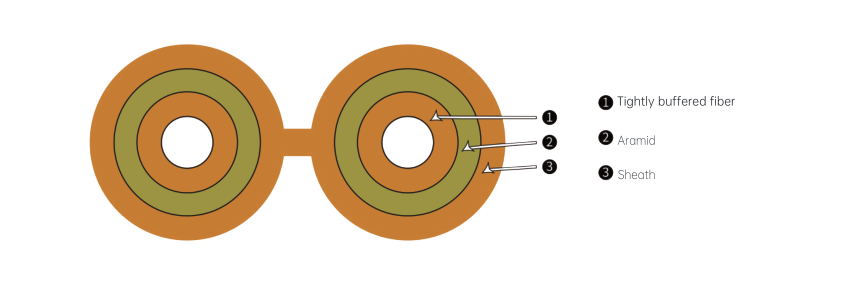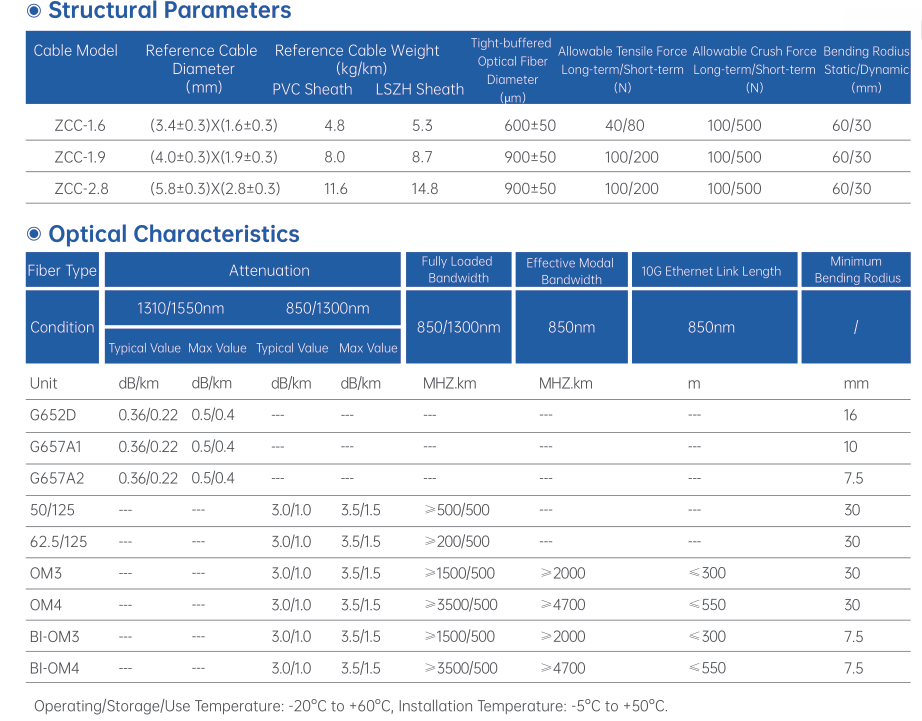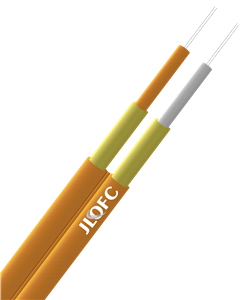ZCC optical cable can meet any of the standards YD/T 1258.2, ICEA-596, GR-409, IEC 60794-2-10/11, which indicates that its performance meets the requirements of relevant industry standards at home and abroad. In addition, in addition to ordinary PVC products, there are products that have passed UL OFNR and OFNP certifications respectively. LSZH products can also meet IEC60332-1 or IEC60332-3C or OFNR certification by selecting different materials. These certifications further prove the quality and performance of ZCC optical cable, enabling it to be reliably used in different application scenarios.
Product Description
A dual-core figure-8 optical cable using 900μm or 600μm tight-buffered optical fibers as optical transmission units,
with aramid yarns as strength members, and finally extruded with a layer of figure-8 polyvinyl chloride (PVC)
sheath. Alternatively, a low smoke zero halogen (LSZH) material sheath can be provided according to customer
requirements.
Product Feature
◆The use of tight-buffered optical fibers facilitates easy stripping.
◆Tight-buffered optical fibers exhibit excellent flame retardancy.
◆Aramid yarn strength members provide outstanding tensile performance for the cable.
◆The outer sheath material offers corrosion resistance,waterproofing, flame resistance, and environmental friendliness.The 8 shaped structure facilitates easy stripping for branch usage.
•Fiber optic patch cords or pigtails for active connections.
•Indoor riser and plenum cabling for vertical shafts and forced ventilation.
•Interconnection of instruments and communication equipment.


Delivery Length
Recommended Length: 2000m; other lengths can be provided according to customer requirements.
Number of Fiber Cores: ZCC optical cables generally have a double-core structure. This design is suitable for scenarios where the demand for the number of fiber cores is not particularly large but duplex transmission is required, such as interconnection of instruments and communication equipment. The two fibers can be used for sending and receiving signals respectively to realize two-way communication.
Fiber Type: Φ900μm or Φ600μm tight-buffered fibers are used as the optical transmission medium. The advantage of tight-buffered fibers is that they are easy to strip for use. When making fiber connections or terminations, the outer protection can be removed more conveniently to expose the fiber core, improving construction efficiency.
Strength Member: A layer of aramid fiber is coated as the stress-reinforcing unit. Aramid fiber has the characteristics of high strength and light weight, which can provide excellent tensile performance for the optical cable. During the laying process of the optical cable, whether it is overhead, pipeline or indoor wiring, the aramid reinforcing element can effectively resist the tensile force, protect the optical fiber from the influence of tension, and ensure the stable transmission of optical signals.
Sheath Material: The outermost layer is extruded with a figure-8 polyvinyl chloride (PVC) or low smoke zero halogen (LSZH) sheath. PVC sheath has good corrosion resistance, waterproofness and certain flame retardancy, and can adapt to general indoor and outdoor environments. LSZH sheath has the characteristics of low smoke, halogen-free and flame retardant. It will not produce a lot of toxic smoke when burned, which is less harmful to personnel and equipment, and is more suitable for places with high fire safety requirements, such as indoor shaft level and forced ventilation level wiring.
Optical Cable Size: The size of ZCC optical cables of different models is different. For example, the size of ZCC-1.6 is (3.2±0.3) × (1.6±0.2) mm, ZCC-1.9 is (3.8±0.3) × (1.9±0.2) mm, and ZCC-2.8 is (5.6±0.3) × (2.8±0.2) mm. The small size makes the optical cable more flexible in laying and can adapt to narrow spaces such as pipelines and trunking.
Transmission Rate: Under normal circumstances, the transmission rate of ZCC optical cable can reach 1000Mbps, which can meet the needs of most data communication and network construction, such as short-distance data transmission in enterprise local area networks, campus networks and other scenarios.
Maximum Single Segment Length: Generally, the maximum single segment length is 100 meters, which is the recommended length under the premise of ensuring signal quality and transmission performance. If a longer transmission distance is required, it can be realized by using optical amplifiers, repeaters and other equipment.
Transmission Wavelength: The transmission wavelength of ZCC optical cable varies according to the type of optical fiber used. If it is a multimode tight-buffered fiber, the common transmission wavelengths are 850nm and 1300nm; if it is a single-mode tight-buffered fiber, the commonly used transmission wavelengths are 1310nm and 1550nm. Different transmission wavelengths are suitable for different transmission distances and application scenarios. For example, 850nm wavelength is suitable for short-distance transmission, and 1550nm wavelength is suitable for long-distance and large-capacity transmission.
Attenuation Characteristics: The attenuation of optical fiber is one of the important factors affecting the transmission distance of optical signals. The tight-buffered fiber used in ZCC optical cable has low attenuation characteristics. At 1310nm wavelength, the attenuation of multimode fiber is generally less than 0.5dB/km, and that of single-mode fiber is usually about 0.35dB/km; at 1550nm wavelength, the attenuation of single-mode fiber can be as low as 0.2dB/km or less. Lower attenuation means that the energy loss of optical signals is small when transmitted in the optical cable, which can ensure the stable transmission of signals over a longer distance.
Dispersion Characteristics: Dispersion will cause the optical pulse to broaden during transmission, thus limiting the transmission rate and distance of the signal. For multimode fibers, there is mainly modal dispersion, and its dispersion coefficient is relatively large, which also limits the transmission distance of multimode fibers to generally within several hundred meters. Single-mode fibers do not have modal dispersion, mainly material dispersion and waveguide dispersion. By reasonably designing the structure and material of the fiber, the dispersion coefficient of single-mode fibers can be made small, so as to realize long-distance and high-speed signal transmission.
Operating Temperature Range: The transportation/storage/use temperature of ZCC optical cable is -20℃~+60℃, and the installation temperature is -5℃~+50℃. Within this temperature range, the optical cable can maintain normal physical and optical properties to ensure the stable transmission of optical signals. Whether in cold northern regions or hot southern regions, as long as it is used and stored within the specified temperature range, the optical cable can work reliably.
Waterproof Performance: Although ZCC optical cable is generally not used in environments that are soaked in water for a long time, it has a certain waterproof capacity. The sheath material itself is waterproof, which can prevent moisture from entering the interior of the optical cable and causing damage to the optical fiber. At the same time, the structure of the tight-buffered fiber can also prevent the penetration of moisture to a certain extent, protecting the optical performance of the fiber from being affected.
UV Resistance Performance: If ZCC optical cable needs to be used outdoors or exposed to an environment with ultraviolet radiation, its sheath material has anti-ultraviolet function. Ultraviolet rays will age some materials and reduce their performance, while the UV-resistant sheath material can effectively resist the erosion of ultraviolet rays and prolong the service life of the optical cable.
Flame Retardant Performance: For example, ZCC optical cable with LSZH sheath material has good flame retardant performance and can meet relevant flame retardant standards, such as IEC60332-1 or IEC60332-3C. In case of fire, flame-retardant optical cables can reduce the spread speed of flames and reduce fire risks.
Tensile Strength: Due to the aramid reinforcing element, ZCC optical cable has good tensile performance. The tensile strength of different types of optical cables is different. For example, the long-term tensile strength of ZCC-1.6 is 40N, and the short-term tensile strength is 80N; the long-term tensile strength of ZCC-1.9 and ZCC-2.8 is 100N, and the short-term tensile strength is 200N. Such tensile strength can ensure that the optical cable will not damage the optical fiber even if it is subjected to a certain tension during laying and use.
Crush Strength: ZCC optical cable can withstand a certain amount of crushing force to adapt to different laying environments. For example, the long-term crushing force of ZCC-1.6 is 60N/100mm, and the short-term crushing force is 300N/100mm; the long-term crushing force of ZCC-1.9 and ZCC-2.8 is 60N/100mm, and the short-term crushing force is 300N/100mm. When laying in pipelines or under the action of other external pressures, the crush strength of the optical cable can ensure that its internal optical fibers are not squeezed, maintaining normal transmission performance.
Bending Radius: ZCC optical cable has certain bending performance, and its minimum bending radius is related to the outer diameter of the optical cable. Generally speaking, the static bending radius is 10 times the outer diameter of the optical cable, and the dynamic bending radius is 20 times the outer diameter of the optical cable. When laying the optical cable, it is necessary to follow the requirements of its minimum bending radius to avoid excessive bending leading to damage to the optical fiber and affecting the transmission of optical signals.
Note:
This document is for reference only and cannot be used as an attachment to the contract.For detailed product information, please contact our sales staff.











